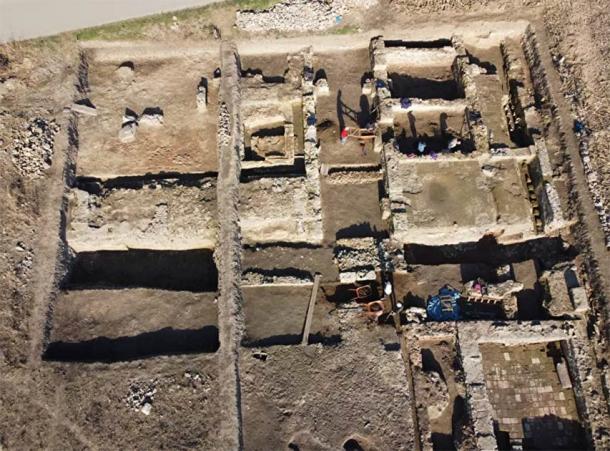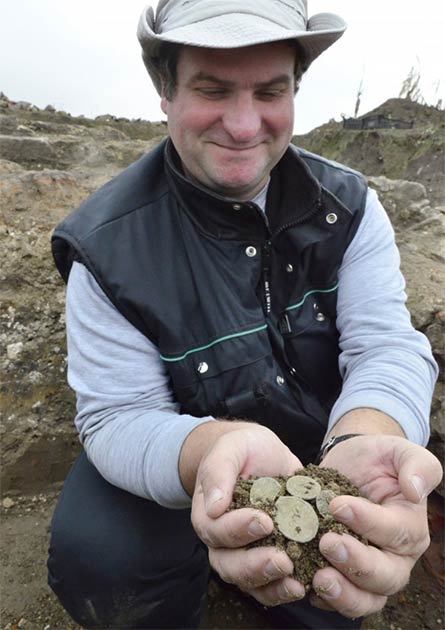
Impressive Roman Military Base Found in Serbian Cornfield
Archaeologists in Serbia have found a Roman military base. Unlike many others, it was not found buried beneath a modern city, but in a rural location. This means that it can help experts to have a better understanding of the Roman army and its organization.
Experts were working on the ancient city of Viminacium, which was once the capital of the province of Upper Moesia. Today it is located near Kostolac, which is due east of the Serbian capital of Belgrade. Archaeologists made the discovery about 1 meter (3 ft.) under the earth in a cornfield. The find was made near a coal mine and was identified during a survey some months ago.
A Unique Roman Military Base
The Roman legion’s headquarters, which in Latin was known as a principium, ‘belonged to the VII Claudia Legion’ reports US News. This famous legion was on active service between the 2nd and 5th century AD. KFGO reports that the legion’s ‘walled camp and Principium were separated from the rest of Viminacium,’ which had its own fortifications. The legion numbered 5,000-6,000 professional soldiers and would have had many camp followers.

Ruins of an ancient Roman tomb at Viminacium. (smoke666 /Adobe Stock)
This discovery is very special as only 100 principia (plural of principium) have been found in the former provinces of the Roman Empire. Miomir Korac, an archaeologist who took part in the dig, told KFGO that “almost all are buried under modern cities.” This makes them difficult to investigate, but this is not the case with the Roman military base recently unearthed in the cornfield.
- Viminacium: Where Mammoths Roamed and Romans Ruled
- Golden Curse Tablets Found in Ancient Serbian Tombs Invoke Gods and Demons
- The Roman Legions: The Organized Military Force Of The Roman Empire
Korac told KFGO that “A very small number of principiums are explored completely (and) ... so we can say this one is unique as it is undisturbed.” During the dig, experts revealed only about a quarter of the site, which is believed to cover an area of 3,500 square meters (37,673.69 sq. ft.) The headquarters was a large compound.

Only a section of the Roman military base near Viminacium has been excavated. (Archaeological Institute in Belgrade)
Mystery Treasure in the HQ
There have been some 40 rooms unearthed at the Roman legion’s base. These rooms had heated walls thanks to an elaborate heating system. The experts also found a shrine and a treasury, where presumably the legionaries’ pay was stored. A parade ground was also unearthed, and once legionaries drilled here, before the eyes of their commanders. A fountain was also found at the site.

Pillars found in the Roman Legion’s headquarters near Viminacium. (Archaeological Institute in Belgrade)
In one room, archaeologists found 120 coins, which would have been a small fortune during the Roman Empire. Why these coins were simply discarded is a mystery. Newsbreak quotes Nemanja Mrdjic, the lead archaeologist, as saying that the coins “must have been lost during an emergency.” This was based on where the coins were found and their distribution. KFGO reports Mrdjic as stating that “The distribution of coins from a corner to the door, ... suggests they (coins) spilled while someone was fleeing.”

The coins would have been considered a small fortune at the time. (B.Subašić)
The Threat of Barbarian Invasions
There is the possibility that the coins were abandoned during an emergency such as a natural disaster, for example, an earthquake. Or they may have been lost and forgotten during an invasion. Viminacium was on an important road and it was of great military significance.
The legions stationed there often had to respond to barbarian incursions on the Danube frontier. During the later years of the Roman Empire, there were near-constant civil wars. The treasure trove of coins could have been lost in one of these endless conflicts.
The discovery of the Roman military base is only the latest astonishing discovery at Viminacium, which was destroyed by the Slavs in the 7th century BC. This buried city has been yielding treasures since the late 19th century. Among the finds that have been made here are a boat, gold tiles, and Roman artwork, including mosaics.
Some 14,000 tombs have also been recorded, and as we reported at Ancient Origins, some ‘golden curse tablets’ were discovered in several of these burials. During previous digs the remains of three mammoths were also revealed.
Despite the many decades of investigations, it is estimated that only 4% of the site has been brought to light. No doubt there are more treasures to be found at the location. Another season of digging is planned for the military barracks, which could reveal more about the VII Legion and the history of the important military center.
Top image: Pillars (Archaeological Institute in Belgrade) and coins (B.Subašić) are some of the discoveries at the Roman military base found near Viminacium in Serbia. (Archaeological Institute in Belgrade)
By Ed Whelan















